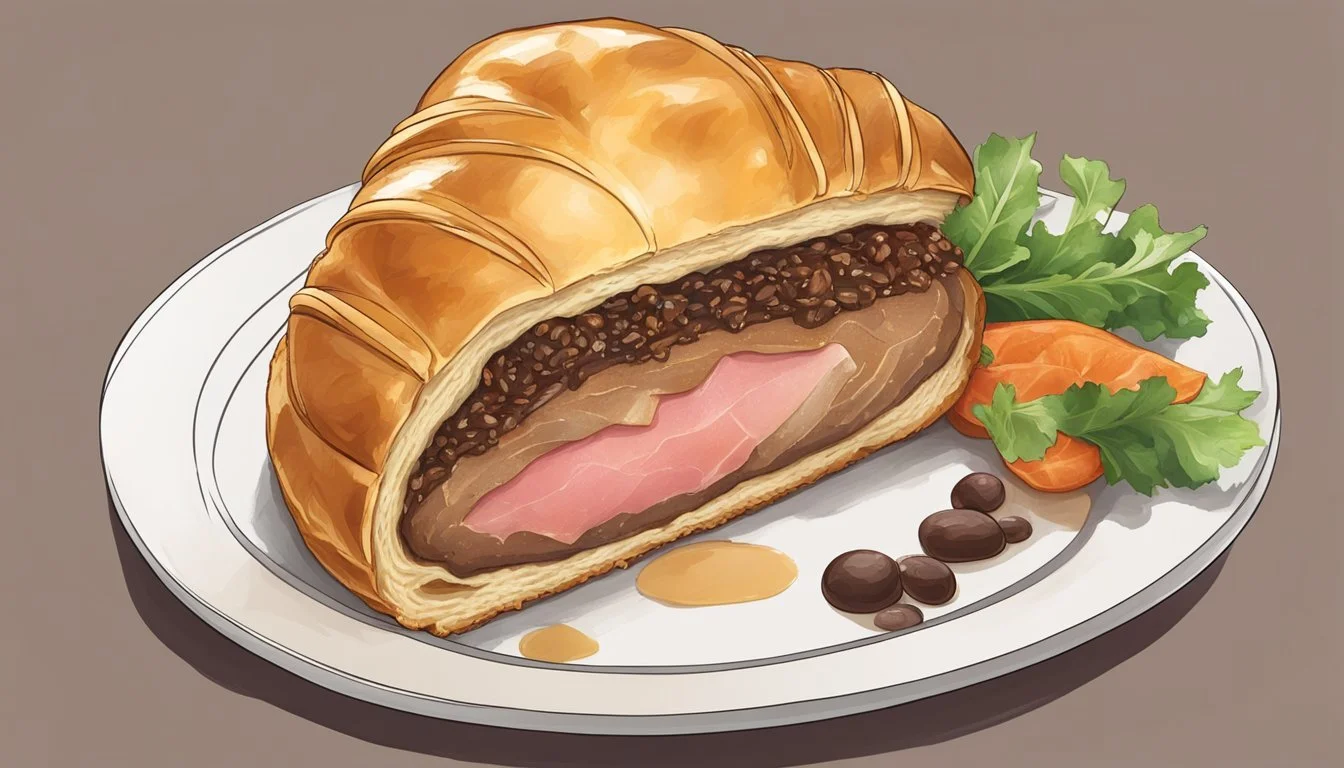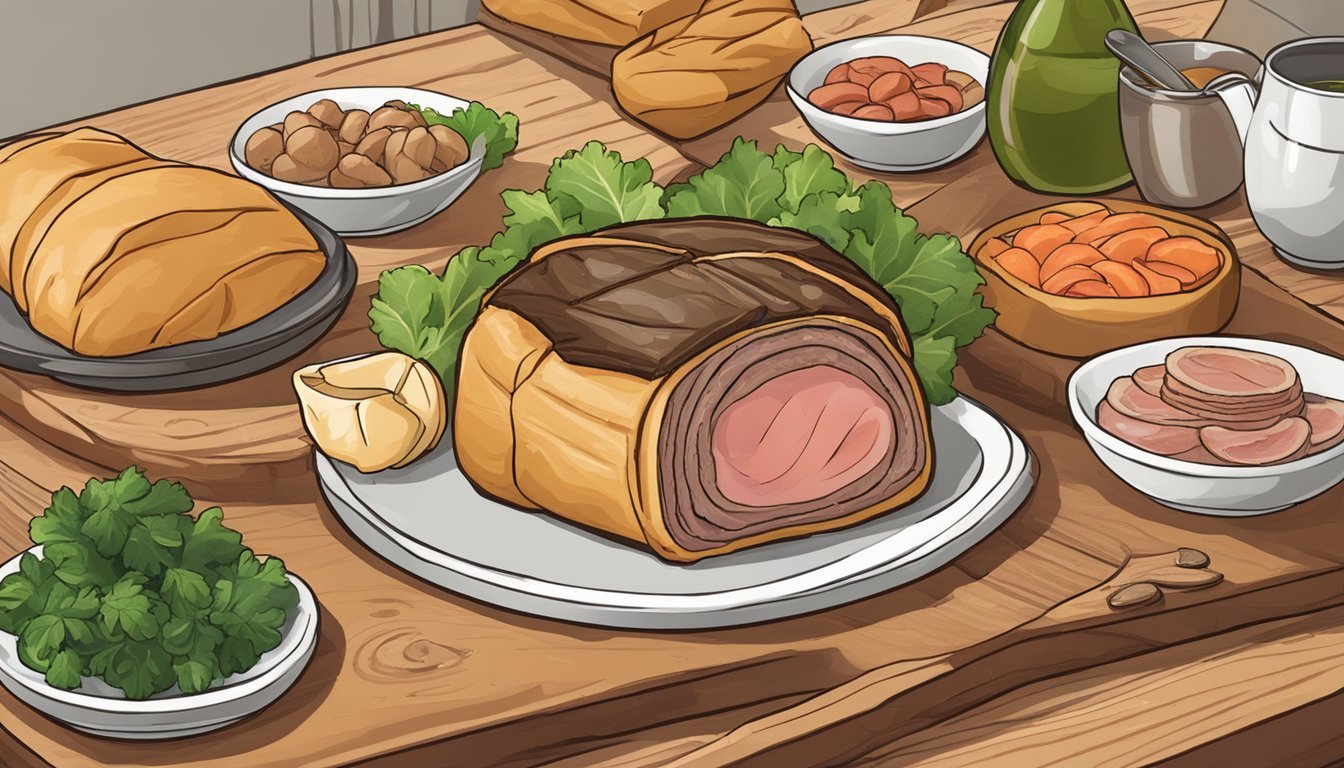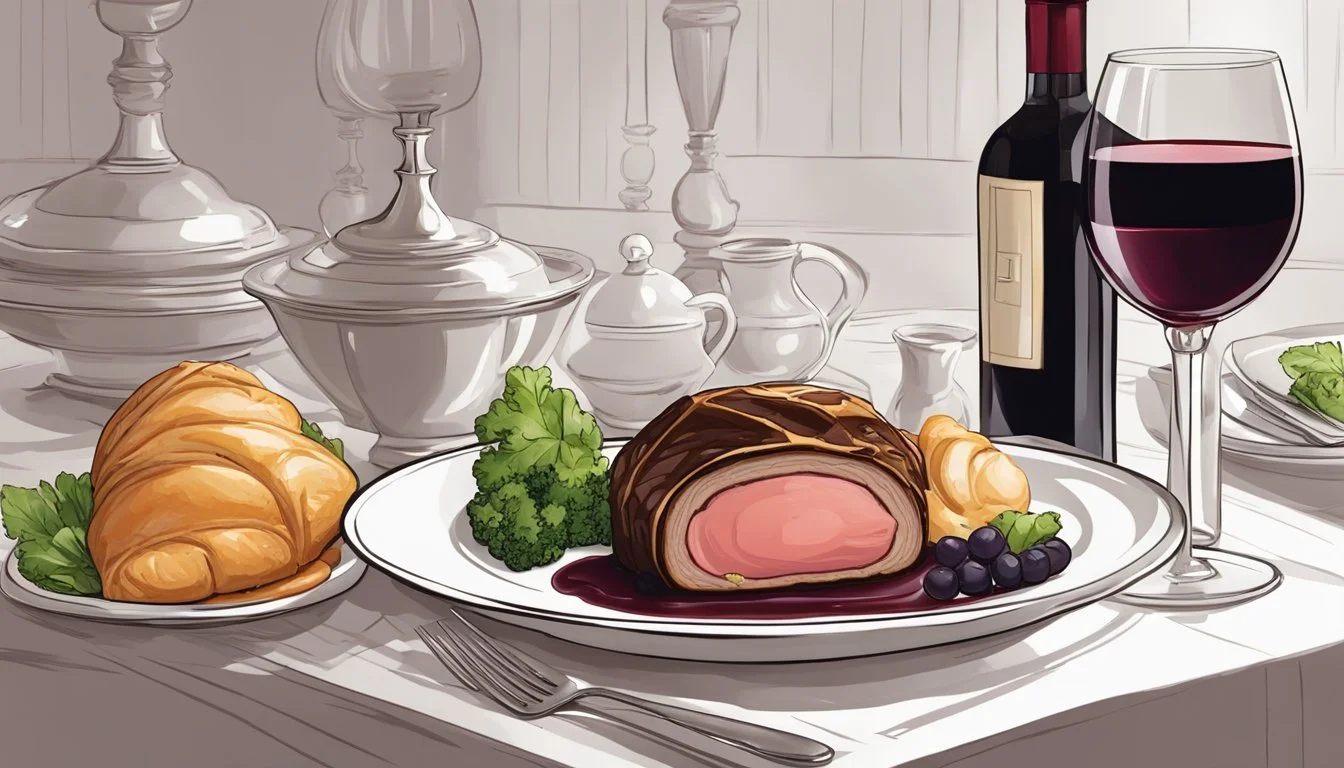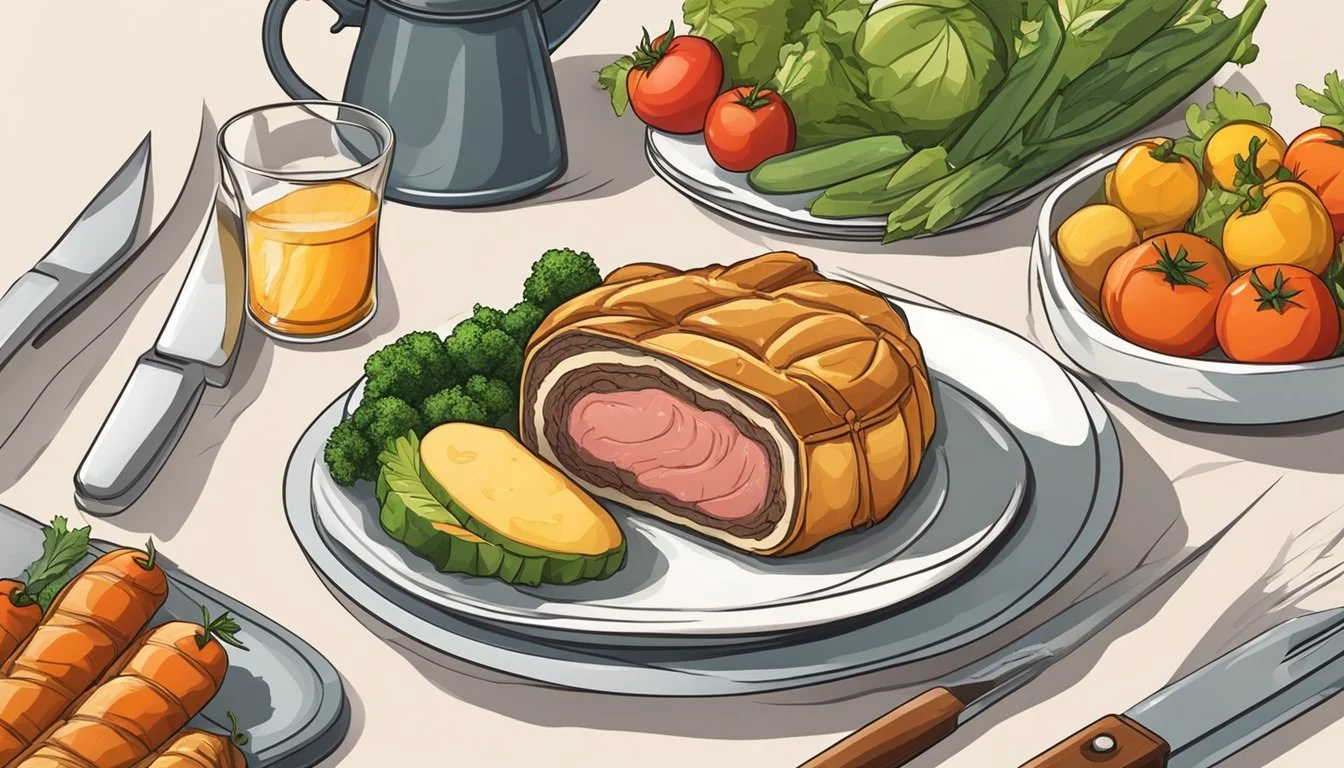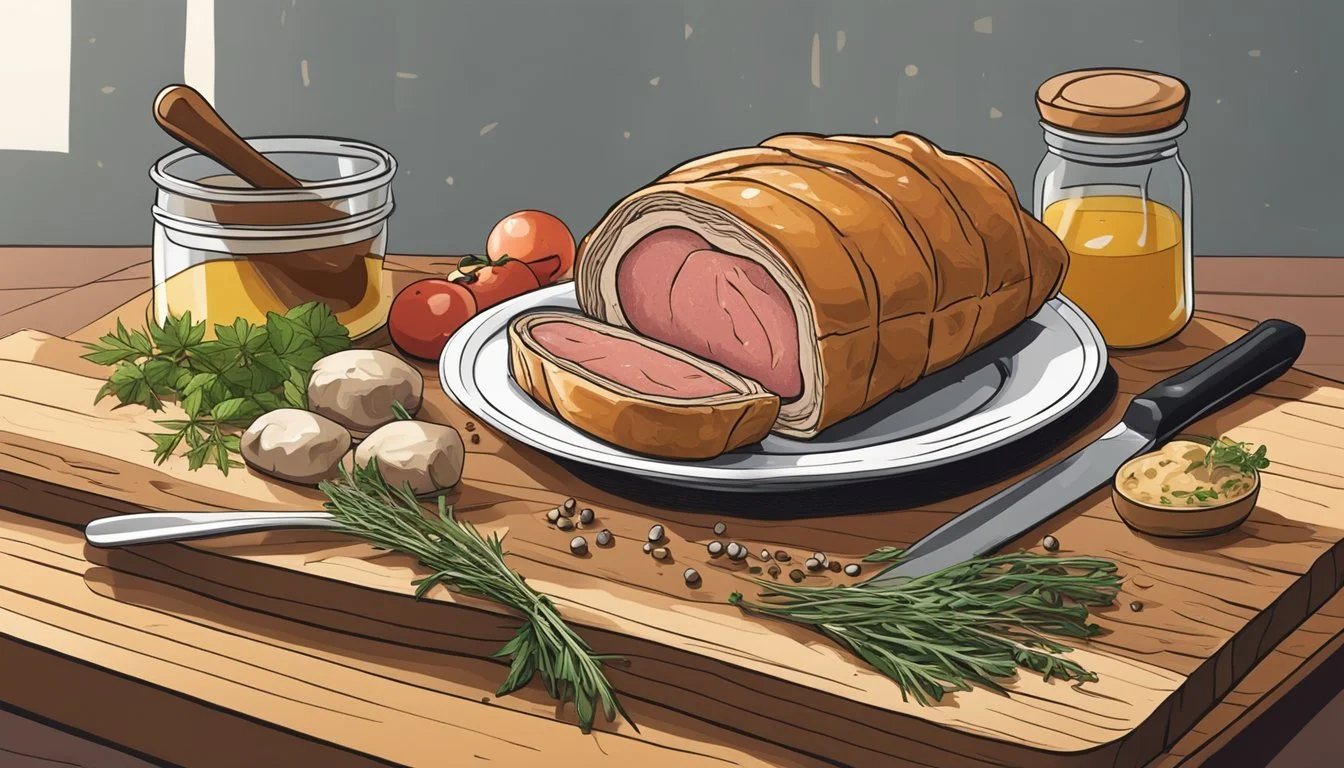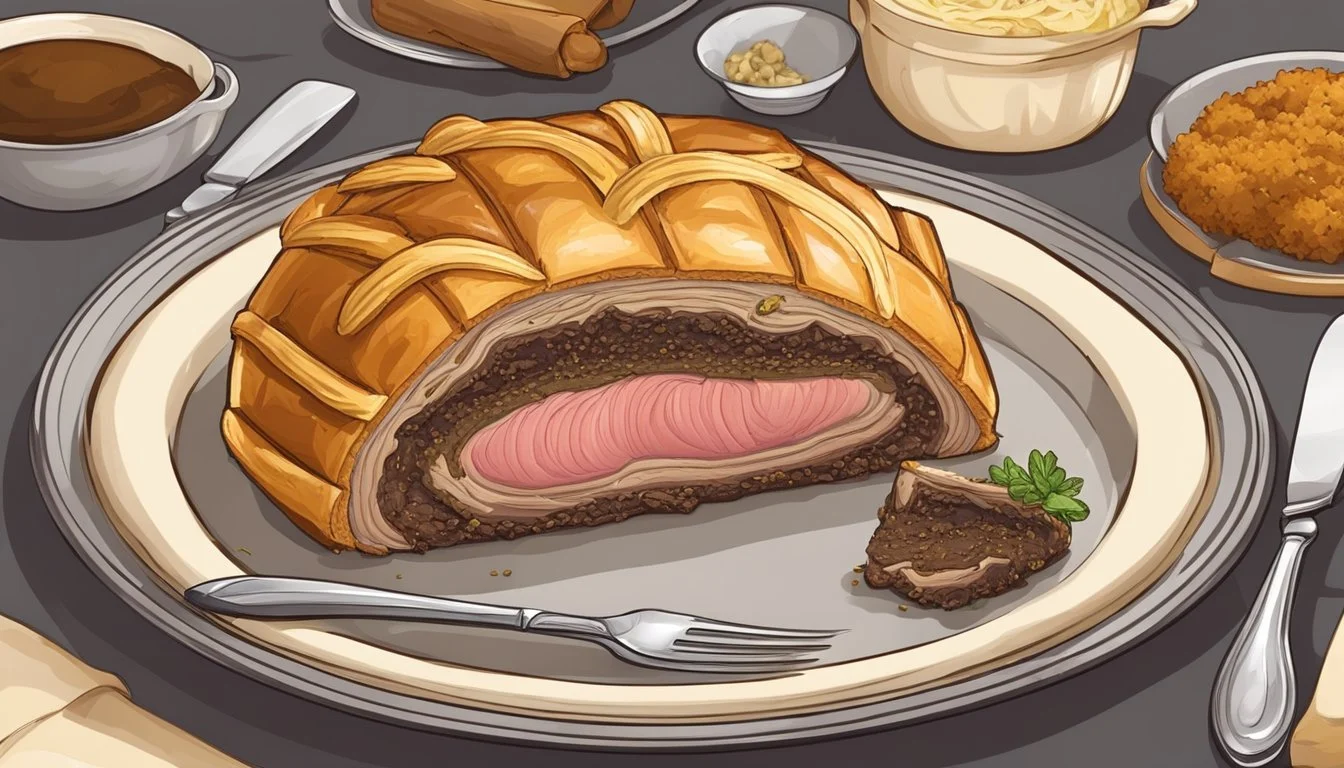How Do You Eat a Beef Wellington?
A Guide to Enjoying This Classic Dish
Beef (What wine goes well with beef?) Wellington is a revered dish known for its rich flavors and elegant presentation, often reserved for special occasions. This classic preparation consists of a tender beef fillet, which has been wrapped in a savory mushroom mixture, often including pâté, and then encased in a buttery puff pastry shell. The result is a harmonious blend of textures and tastes—crisp pastry giving way to succulent meat with a rich, flavorful heart.
The enjoyment of Beef Wellington (What wine goes well with beef Wellington?) extends beyond its taste; the dish is also a visual and textural delight. The pastry is golden and flaky, providing a delightful contrast to the tender, perfectly cooked beef inside. When sliced, the layers reveal the complexity of its construction, with the duxelles and possible additions like prosciutto or a crepe barrier adding depth to the flavor profile.
For those who appreciate a dish with a sense of occasion, Beef Wellington delivers on all fronts. It is as much a pleasure to behold as it is to eat, making it a prized centerpiece for celebratory dinners or any time one seeks to serve something truly special. Each component of the dish plays an important role, coming together to create an exquisite culinary experience.
What Is Beef Wellington?
Beef Wellington is a celebrated dish combining a tender cut of beef with a rich amalgamation of flavors, all encased in a flaky pastry crust.
Origins and History
The dish, believed to be named after the first Duke of Wellington, Arthur Wellesley, has origins that are a matter of culinary debate. Some theories suggest it's inspired by the French "filet de bœuf en croûte," while others consider it a patriotic rebranding of a classic recipe during the 19th century.
Key Components
Tenderloin: The centerpiece is a succulent, center-cut tenderloin, also known as filet mignon when cut into steaks, which comes from the cow.
Puff Pastry: Enveloping the meat, puff pastry provides a golden and crisp outer layer.
Mushroom Duxelles: A finely chopped mixture of mushrooms lends an earthy flavor.
Prosciutto: This cured ham adds a touch of salty richness and moisture barrier between the meat and pastry.
Beef Wellington Today
Modern renditions of Beef Wellington may feature creative adaptations, but the core elements remain consistent: high-quality beef tenderloin (What wine goes well with beef tenderloin?), a savory mushroom mixture, and the quintessential wrapping of puff pastry. This dish continues to hold a place of esteem on tables around the world, often served during special occasions.
Ingredients and Substitutions
Creating the perfect Beef Wellington requires a careful selection of ingredients and an understanding of viable substitutions to accommodate different dietary needs or preferences.
Essential Beef Wellington Ingredients
The classic Beef Wellington comprises several key components that form its unique flavor and texture profile:
Tender beef: A center-cut beef tenderloin, known for its tenderness, is the preferred cut for this dish.
Puff pastry: This buttery, flaky pastry encases the beef and its accompaniments.
Mushrooms: Typically, a duxelles made from finely chopped mushrooms, along with shallots and thyme, adds depth and earthiness.
Prosciutto: Thinly sliced, it wraps around the beef, imparting a subtle, savory saltiness.
Shallots and Garlic: Essential aromatics that enhance the duxelles.
Mustard: Dijon mustard is often used to coat the beef, adding a tangy flavor.
Egg wash: Beaten egg brushed on the puff pastry for a golden finish.
Butter, Olive oil, Salt, and Pepper: For sautéing and seasoning throughout the preparation process.
Common Substitutions
Substitutions can be made for nearly every component of Beef Wellington to suit dietary restrictions or taste preferences:
For Mushrooms: If mushrooms are not desirable, one might use chopped chestnuts for a similar texture.
For Prosciutto: Vegetarian versions of Beef Wellington may omit prosciutto or use a vegetarian alternative.
For Puff Pastry: Gluten-free puff pastry can be used for those with gluten sensitivities.
For Mustard: Various types of mustard or a mixture of different mustards can be used depending on the desired flavor profile.
For Butter and Olive Oil: Those with dairy intolerance can opt for dairy-free butter or simply use more olive oil.
For Egg Wash: An alternative for vegans is to use a mixture of plant-based milk and syrup for a similar glaze effect on the pastry.
Preparation Techniques
The preparation of Beef Wellington is an exercise in coordination, skill, and precision. Mastering the techniques of preparing the beef tenderloin, making the duxelles, and assembling the Wellington are essential for a successful dish.
Preparing the Beef Tenderloin
To start, one must season the tenderloin generously with salt and black pepper. This not only adds flavor but also aids in forming a crust. The tenderloin should then be seared in a hot skillet to create a flavorful brown crust while locking in juices. This sear should be quick, leaving the inside rare as the cooking process will continue in the oven.
Making the Duxelles
Duxelles, a finely chopped mixture of mushrooms, shallots, and garlic, is crucial for imparting earthy flavors (What wine goes well with earthy flavors?) into the Wellington. After seasoning with thyme, one should cook the mixture until all the moisture evaporates and the mixture becomes a paste-like consistency. This intensifies the flavor and ensures that no additional moisture seeps into the puff pastry. A food processor can facilitate finely chopping the mushrooms and shallots if needed.
Assembling the Wellington
To assemble, lay plastic wrap on a flat surface and create a bed of prosciutto slices, slightly overlapping. Spread the cooled duxelles over the prosciutto, providing an even layer of flavor and fat to envelop the tenderloin. Wrap the duxelles and prosciutto around the beef, using the plastic wrap to roll it tightly, and then chill in the refrigerator. This will ensure the structure holds its shape. The final step involves wrapping the entire tenderloin in puff pastry, sealing the edges to prevent any juice from escaping during the baking process.
Cooking Instructions
Preparing Beef Wellington requires precise oven preparation and baking, followed by thorough checks to ensure the desired level of doneness. Careful attention to temperature and timing ensures even cooking for a perfectly textured dish.
Preheat and Prep the Oven
One begins by positioning the oven rack in the upper third or middle section and preheating the oven to a specific temperature. Recipes may vary, but a common requirement is a preheat temperature of 400°F (204°C) or 425°F (218°C). Meanwhile, one should prepare a baking sheet by greasing it or lining it with parchment paper for a non-stick surface.
Baking the Wellington
The Wellington, assembled with beef tenderloin encased in a layer of mushroom mixture and puff pastry, should be transferred to the prepared baking sheet. Prior to baking, it is often brushed with an egg wash to promote golden brown browning of the pastry. The baking process typically ranges from 22 to 28 minutes, depending on the desired level of doneness, be it rare, medium-rare, or medium.
Checking for Doneness
Use a meat thermometer to check the internal temperature of the beef. For medium-rare, aim for a temperature of 130°F-135°F (54°C-57°C), and for medium, a temperature of 145°F (63°C) is advisable. Post baking, it is essential to allow the Beef Wellington to rest for a span of 5 minutes to ensure the meat's juices redistribute, enhancing flavor and texture.
Side Dishes and Pairings
When serving Beef Wellington, the choice of accompaniment can enhance the flavors of the dish. Well-paired side dishes not only complement the textures and tastes but also round out the meal beautifully.
Traditional Sides
Mashed potatoes are a classic choice, providing a creamy base that contrasts with the Wellington's crisp pastry. Green beans and carrots, either steamed or roasted, add a touch of vibrancy to the plate while offering a slight crunch for textural variety. A robust gravy or sauce, such as a red wine reduction, can tie these elements together with a rich, savory note.
Potatoes: Mashed, roasted, or boiled
Vegetables: Carrots, green beans, Brussels sprouts
Sauces: Rich gravy, red wine sauce
Modern Twists on Classic Pairings
Incorporating modern twists, a carrot puree brings a smooth, slightly sweet dimension to the dish. Rice pilaf offers a light, fluffy alternative to potatoes with subtle flavors that don't overpower the Wellington. Asparagus wrapped in bacon combines smokiness and tenderness, making it a satisfying yet contemporary side. Lastly, a crisp salad, possibly featuring a tangy dressing, can cleanse the palate between bites of the rich main course.
Vegetable Purees: Carrot puree infused with ginger
Grains: Fragrant rice pilaf
Innovative Vegetables: Asparagus with bacon, Brussels sprouts with a twist
Salads: Fresh greens with complementary dressings
Serving and Presentation
Proper serving and presentation are crucial for the enjoyment of Beef Wellington as they ensure that each slice showcases a perfect blend of flavors and textures, from the center-cut beef to the surrounding pastry.
Slicing the Wellington
To maintain the Beef Wellington's juicy center and crisp pastry, it is important to let it rest before slicing. A very sharp knife is necessary to cleanly cut through the layers without crushing the delicate pastry. It's recommended to slice the Wellington into portions about 1 inch thick, ensuring each piece contains the full spectrum of textures, from the tender, moist center-cut beef to the rich truffle or parma ham layers and flaky crust.
Plating and Garnish
Plating Beef Wellington should be done with intention to enhance the dish's visual appeal. Plate each slice against a backdrop of complementary sauce which can be a rich red wine reduction or a silky béarnaise to accentuate the flavors. A garnish should never overpower; consider a light sprinkle of sea salt or a small sprig of fresh herb for color contrast and a subtle aroma. The presentation of the plated dish should highlight the Wellington’s golden pastry and the succulent cross-section of its ingredients.
Wine and Sauce Pairings
When enjoying Beef Wellington, selecting the ideal wine and sauce can elevate the dish to new heights. The richness of the beef and the flaky pastry are complemented by full-bodied wines and sumptuous sauces.
Choosing the Right Wine
For the perfect marriage with Beef Wellington, one should opt for a wine that balances the dish's savory flavors. Côte Rôtie and Barolo are top choices due to their elegant structure and robust profiles. These wines, with their exceptional tannins, cut through the richness of the meat and enhance its natural flavors. Additionally, a well-aged Bordeaux blend or a bold Cabernet Sauvignon could also be excellent counterparts, bringing both a harmony and a contrast to the tender beef and the umami of the mushrooms.
Pinot Noir: A classic selection from regions renowned for their Pinot Noirs ensures a delicate complement to the dish.
Syrah: Its compatibility with beef dishes, including Wellington, is notable for not overwhelming the palate.
Complementary Sauces
Sauces serve as an essential element, not only adding moisture but also reinforcing or introducing new flavors to the dish. A red wine reduction, often accomplished with a high-quality red wine, beef stock, and sometimes a hint of brandy, remains a popular choice because of its depth and ability to amalgamate all elements of the Wellington.
Mushroom Sauce: Usually inclusive of heavy cream, butter, and shallots, this sauce underlines the mushroom components within the Wellington.
Mustard sauce: Varieties such as English mustard and Dijon mustard can be subtly integrated, typically with heavy cream, to create a sharp yet creamy sauce that contrasts nicely with the dish's richness.
Each sauce should be carefully balanced to avoid overshadowing the primary flavors of the beef and pastry.
Nutritional Information
Beef Wellington is a sumptuous dish that combines rich flavors and varying nutrition depending on its preparation. The dish typically has a notable caloric content and contains a balance of protein and fats.
Caloric Content
Beef Wellington is calorie-dense due to its ingredients. One serving often contains:
Calories: Approximately 354 to 427 kcal
Carbohydrates: Ranges from 17 grams (6% of daily value) to 31.5 grams
This variation reflects different recipes and serving sizes.
Protein and Fat Breakdown
The nutritional composition of Beef Wellington is:
Protein: About 29% of the caloric content
Total Fat: Can vary significantly, with an average of 34 grams per slice
Saturated Fat: Roughly 11 grams (55% of daily value)
Trans Fat: Around 0.2 grams
Polyunsaturated and Monounsaturated Fat: Approximately 20 grams combined
Proteins and fats are influenced by the beef and pastry constituents, as well as any additional ingredients used in the dish.
Storage and Leftovers
To maintain the quality of Beef Wellington while ensuring safety, proper storage and reheating methods are essential. These processes help in preserving flavor, texture, and nutritional value.
Storing Beef Wellington
After enjoying a meal, one might find themselves with leftover Beef Wellington. In order to keep it fresh for future consumption, it's advised to store it correctly. Leftovers should be placed in an airtight container or tightly wrapped in plastic wrap to protect from air exposure. For best quality, Beef Wellington should be consumed within 2 days when stored in the refrigerator at or below 40°F (4°C). However, if one needs to store it for a longer period, freezing is an option. Here is a brief guide for freezing:
Wrap the individual slices or entire Beef Wellington tightly in plastic wrap or aluminum foil.
Place the wrapped portions in a freezer bag.
Label the bag with the current date to keep track of how long it’s been stored.
Expel as much air as possible before sealing the bag to prevent freezer burn.
Store in the freezer where it can remain for up to 2 months for optimal taste and safety.
Reheating Instructions
Reheating Beef Wellington properly is crucial to retain its desirable qualities. It's recommended to thaw frozen Wellington in the refrigerator for several hours or overnight before reheating to ensure even warming. Never thaw at room temperature due to food safety concerns. For reheating, the oven method is preferable to maintain tenderness and moisture:
Preheat the oven to 275°F (135°C) for a gentle reheat.
Place the Beef Wellington on a baking tray and cover loosely with foil to keep it moist.
Heat until the internal temperature reaches 165°F (74°C) as recommended by food safety guidelines.
Check that it's warmed through before serving to ensure the best experience.
Remember, microwaves can unfavorably affect the texture and can lead to uneven heating, hence it's not a recommended method for foods like Beef Wellington.
Common Mistakes to Avoid
When preparing Beef Wellington, ensuring that the dish is flavorful, well-textured, and pleasing to the eye is paramount. To achieve this, one must avoid certain pitfalls that can turn this delicacy into a culinary disappointment.
Overcooking
Beef Wellington should be baked to achieve a balance between the tender beef and the flaky pastry. Overcooking it can lead to a dry and tough interior. Bake the beef Wellington at 425 degrees Fahrenheit for about 30 minutes, and use a meat thermometer to check that the internal temperature of the beef reaches 145 degrees Fahrenheit for medium-rare. It's crucial to let the beef rest before slicing to distribute the juices.
Underseasoning
The seasoning of Beef Wellington can make or break its flavor profile. The fillet should be seasoned generously with salt and pepper before searing, which not only adds taste but also helps to create a crust that seals in moisture. When preparing the duxelles, an assortment of herbs and shallots should be included for depth of flavor. Here is a list for seasoning components:
Salt & Pepper: A liberal amount should be applied to the beef.
Herbs & Shallots: Must be balanced to complement and not overpower the beef.
Soggy Pastry
To avoid a soggy pastry shell, two things should be ensured. Firstly, the moisture from the mushroom duxelles should be controlled. Saute them until they're dry, as excess moisture can cause the pastry to become soggy. Secondly, searing the beef quickly at a high temperature prior to wrapping helps to seal in the juices. Furthermore, when assembling, one should leave a border around the puff pastry to prevent the edges from becoming drenched with any escaping moisture.
Advanced Tips and Tricks
In the culinary journey of creating a Beef Wellington, mastering the art of searing and pastry preparation is crucial for an exquisite result.
Achieving the Perfect Sear
To attain an impeccable sear, one must ensure the beef is dry before it hits the pan. They should pat the beef dry with paper towels to remove excess moisture. They must heat a heavy skillet to a high temperature then add a small amount of high-smoke-point oil. It's important to sear the beef until a deep brown crust forms, usually for 2-3 minutes per side. This browning is the Maillard reaction at work, which imparts richer flavor to the dish.
Quick Searing Guide:
Step Action Reason 1. Dry the beef Pat with paper towels Removes moisture for better browning 2. Preheat the pan Use high heat Ensures immediate browning and flavor development 3. Add oil A high-smoke-point oil like canola Prevents burning and sticks to the pan 4. Sear 2-3 minutes per side Achieves a deep crust and locks in juices
Creating Flaky Pastry
Flaky pastry is the hallmark of a well-prepared Beef Wellington. The puff pastry should be kept cold before usage to prevent the butter from melting prematurely. The deployment of flour on the work surface must be judicious to avoid a tough pastry. The pastry must envelop the beef and duxelle snugly, but without compressing the layers, to allow steam to puff the layers evenly. Once the pastry is prepared, they should chill it again before baking to set the shape and ensure a crisp texture upon completion.
Pastry Perfection Checklist:
Keep puff pastry cold before rolling out.
Use just enough flour to prevent sticking but not so much that it toughens the pastry.
Wrap the pastry around the beef and duxelle snugly, without compressing.
Chill shaped Wellington before baking to set the pastry.
Bake until golden brown, indicating a crisp, flaky texture.
Alternative Recipes and Variations
Beef Wellington, traditionally made with beef, mushrooms, pate, and pastry, can be modified to suit dietary requirements or preferences. These alternatives use a variety of ingredients and substitutions to recreate the classic dish.
Vegetarian and Vegan Options
For a vegetarian variant, one can substitute beef with root vegetables or lentils to mimic the texture and richness. A popular combination involves root vegetables such as sweet potatoes and parsnips, coupled with lentils for protein, all spiced accordingly. The mushroom duxelles can remain a staple in the vegetarian version, or ground nuts and seeds can be incorporated for added texture and flavor.
Vegans can enjoy a Wellington by using plant-based substitutes for both the beef and pastry components. The beef can be replaced with a mixture of mushrooms, chickpeas, and nuts to create a filling with depth and umami flavors. Vegan pastry is fashioned using shortening or oil-based margarine instead of butter, and an almond milk or soy milk wash can create the desired golden crust.
Gluten-Free and Low-Carb Adaptations
Gluten-free adaptations involve switching out standard puff pastry for a gluten-free alternative made with a blend of rice flour, tapioca flour, and xanthan gum to achieve the necessary rise and flakiness. Care must be taken to ensure all other ingredients, such as seasonings and stock, are also gluten-free.
For those seeking a low-carb option, a beef Wellington can be made with a crust of almond flour and coconut flour based pastry, reducing the carbohydrate content significantly. The pastry might not puff as traditional versions do, but it offers a satisfying texture and flavor. Additionally, the duxelles mixture can be altered to include less carb-dense ingredients like spinach or kale in place of some mushrooms.
Occasions and Celebrations
Beef Wellington is often reserved for times when a host wants to impress their guests with a luxurious and visually stunning main course. It's a central feature in special celebrations where both flavor and presentation are paramount.
Holiday Gatherings
During holiday seasons, families often look for a show-stopping centerpiece for their feast. Beef Wellington, with its rich flavors and elegant presentation, is a superb choice for such occasions. Whether it's gracing the Christmas table or being the highlight of a New Year's Eve dinner, it brings a sense of grandeur to any family get-together. Hosting a holiday meal centered around Beef Wellington can make the celebration even more memorable.
Elegant Dinner Parties
For hosts who aim to convey sophistication and culinary expertise, Beef Wellington stands as a top pick. Its intricate layers of meat, mushroom duxelles, and puff pastry demand skill and attention to detail, showcasing the host's dedication to their craft. This dish's aesthetically pleasing appearance coupled with its delicious taste can garner appreciation from guests, making it a favorite for dinner parties that aim for an atmosphere of exclusivity and elegance. Social media platforms like Instagram often feature Beef Wellington at such events, highlighting it as a symbol of a well-curated dining experience.


